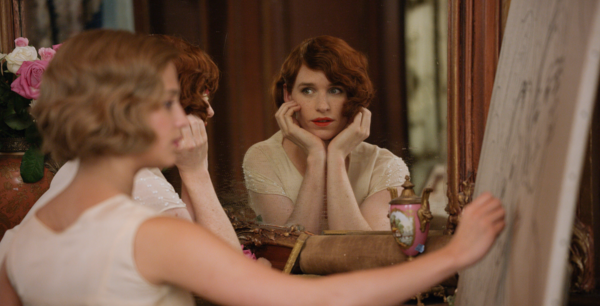As couples throughout the history of art and creativity have shown us time and time again, to be with another artist seals one’s fate for a life characterized by the surreal and insane. A prime example of this in the world of painting is Einar Wegener and Gerda Gottlieb, a married couple that ends up unlocking something that’s been within Einar his entire life: a woman.
Though Einar (Eddie Redmaybe) is already a successful landscape artist in his own right, Gerda (Alicia Vikander) is trying to make a name for herself with her paintings–which leads her to ask Einar to pose for her in place of the female model that’s no longer available to help her finish when she needs to. As Einar dons the shoes and stockings, and then drapes the dress over himself, a sort of heady intoxication comes over him–the kind that indicates there’s more meaning to this putting on of women’s accoutrements than meets the eye. As Gerda’s friend, Ulla (Amber Heard), comes into the room with a bouquet of lilies and sees the spectacle, she laughs and dubs Einar’s new persona Lili.
From this moment forward, Gerda and Einar see his essence in a new light–with Gerda taking creative advantage by painting Lili in all manner of poses and scenarios. When Einar’s art dealer sees the final products, he is at last interested in Gerda’s work. Though Lili’s presence bodes well for Gerda’s professional life, it signals the demise of her marriage, especially after Gerda catches “Lili” kissing Henrik (Ben Whishaw) at a gala event thrown by Ulla. Though Henrik knows Lili is really Einar, his homosexuality makes Einar/Lili an ideal match for sexual experimentation–though Lili doesn’t quite see it that way.
Concerned about Einar’s state of gender confusion, Gerda takes him to see a doctor where he is given radiation treatments that only further aggravate his already delicate state. The doctor is horrified to find no improvement in Einar’s “condition” after the “therapy,” afterward mailing Gerda a letter that indicates Einar is going to have to be locked up in an asylum. When Gerda is asked to do a solo show in Paris, she sees it as an opportunity to flee with Einar so that they can start over again. But matters only intensify in Paris, the city of ultimate gender-bending one might say.
Director Tom Hooper, no stranger to Oscar baiting with past films like The King’s Speech and Les Misérables, imbues playwright (and now screenwriter) Lucinda Coxon’s script with the tortured subtlety it merits, shedding light on the tortured existence of both Einar and Gerda as they come to terms with the fact that Lili isn’t going to go away. Reconciling the notion of her husband’s essential death, Gerda finds comfort in one of Einar’s childhood friends, Hans Axgil (Matthias Schoenaerts), an art dealer who admits that, yes, he kissed Einar when they were kids because “he just looked so pretty.” Indeed, there can be no denying that Einar’s feminine side has always been more overpowering, and has only just now been unleashed with full force.
So unable to cast aside his true self is Einar that he ends up taking a huge gamble by becoming the first person to undergo sexual reassignment surgery. And while the first half of the procedure–removing his penis–goes rather seamlessly, it is the implementation of a vagina that results in Einar/Lili’s undoing–just as much as Gerda’s.
Based on David Ebershoff’s mildly revisionist tale of the couple, The Danish Girl presents all the sorrows and lunacies of two artists in love; and this truism shines through no matter how stylized the narrative may have become for cinematic purposes.























[…] goodbye to his ex/the daughter of Jean-Luc, Anne Marie (Alicia Vikander, much more worthwhile in The Danish Girl) and fully opens his heart to Helene. For you see, no one can more lazily complete the bad boy gone […]
[…] is no exception. Although the film was released in 2014, a year before Tom Hooper’s The Danish Girl, it seems to lack the same amount of humanity as the latter–though both favor the use of […]